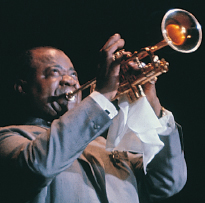Biography: Louis Armstrong (1901–1971)

Louis Armstrong was born into abject poverty in New Orleans. He learned to play the cornet in the Colored Waifs’ Home, where he had been placed as a juvenile delinquent. Armstrong played in seedy clubs and on riverboats, which were floating dance halls that traveled from town to town on the Mississippi every summer. Riverboats became a cradle of early jazz, importing it up the river from New Orleans to Kansas City and other centers.
Soon Armstrong was playing in pioneering jazz bands led by King Oliver (see page 389) and Fletcher Henderson. He rapidly emerged as a more exciting artist than any of his colleagues. His sophisticated, flowing rhythms, his imaginative breaks and variations, and the beauty and sheer power of his trumpet tone — all these were unique at the time. A famous series of records he made in the 1920s, playing with small New Orleans–
In the 1930s the popularity of jazz led to a great deal of commercialization, and to the cheapening and stereotyping that always seem to result from this process. Armstrong went right along, while often contributing moments of breathtaking beauty to records that were “listenable virtually only when Louis is playing,” according to one jazz critic of the time. Armstrong became a nationally loved star, familiar from his appearances in nearly twenty movies. The State Department sponsored him on so many international tours that people called him “Ambassador Satch” (“Satchmo,” his nickname, was derived from “satchel-
However, the more successful Armstrong became in the world of popular music, the more he drifted away from true jazz, to the distress of jazz enthusiasts. His last hit record was Hello, Dolly!, the title song of a 1964 Broadway musical; in this number he sang (with his famous raspy delivery) more than he played the trumpet.
Encore: Listen to “West End Blues,” “Heebie Jeebies,” “Hotter Than That,” “St. Louis Blues” (with Bessie Smith).
Image credit: Bettmann/Corbis.